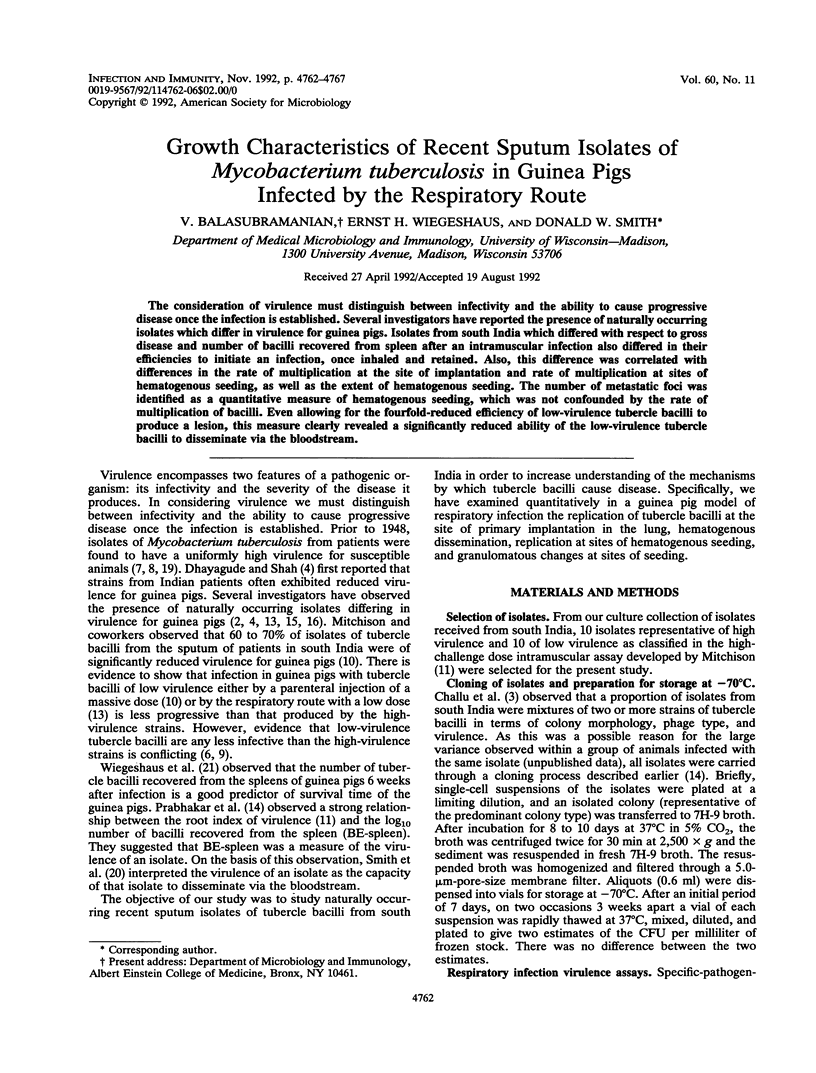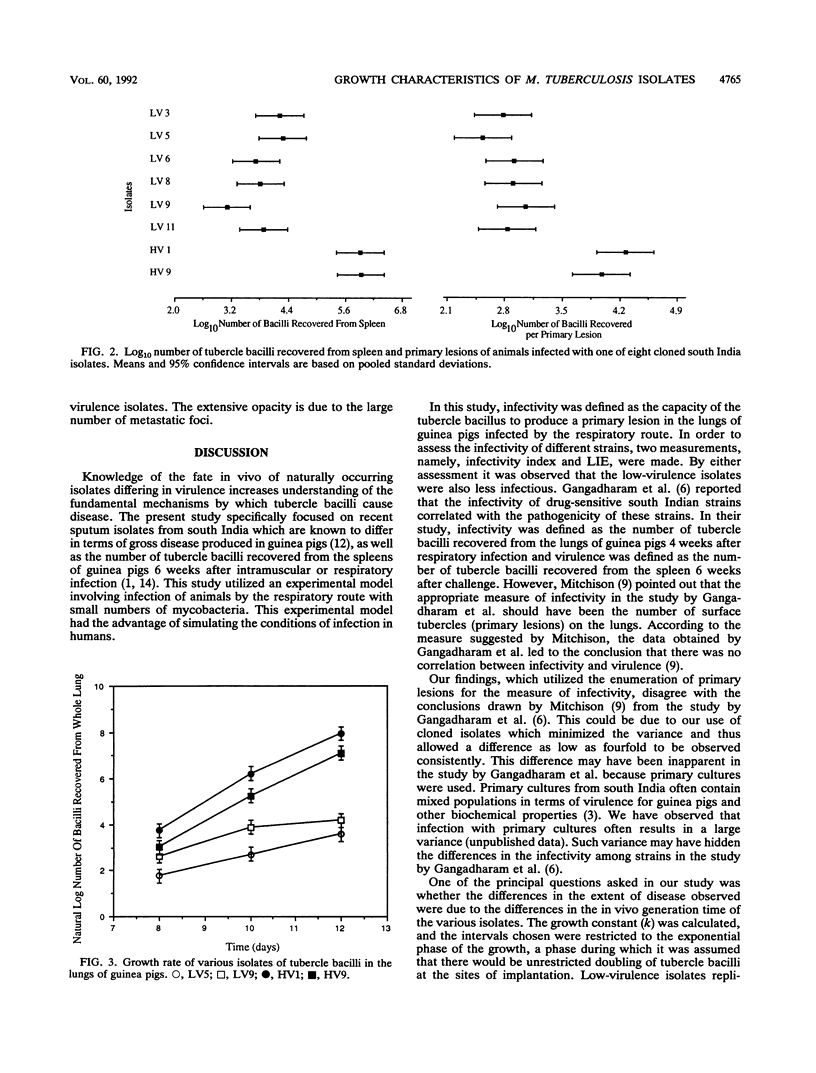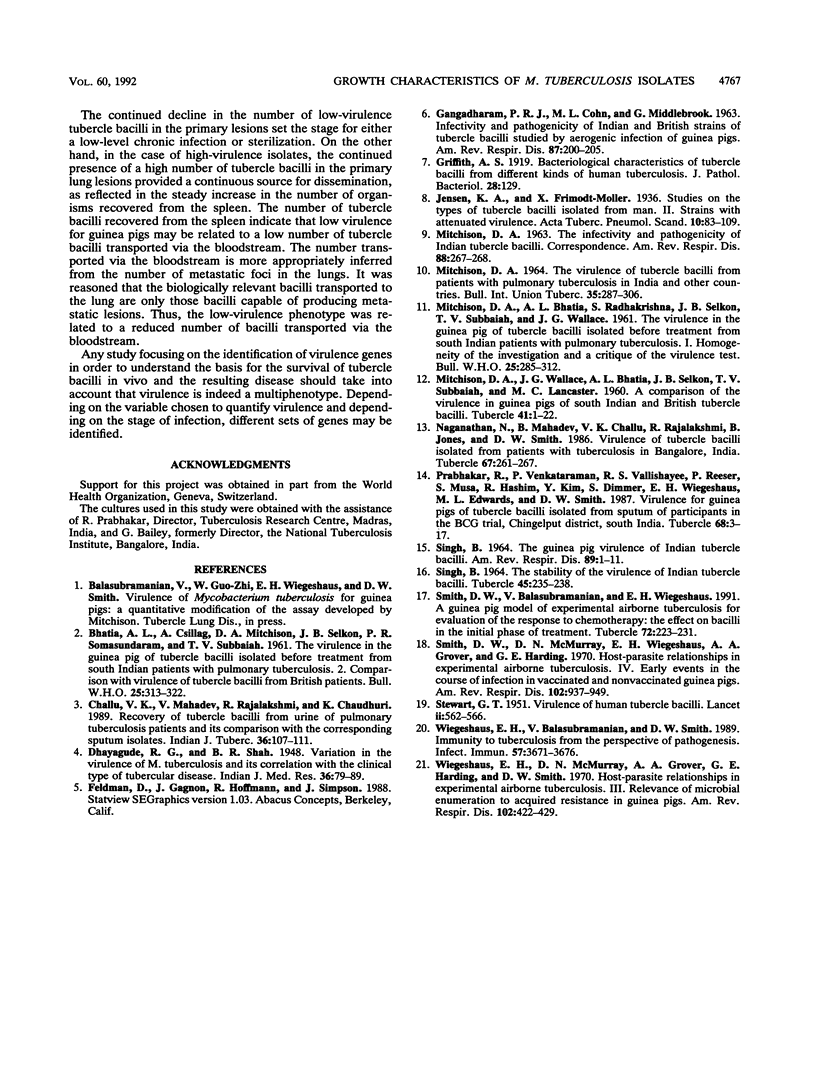Abstract
The consideration of virulence must distinguish between infectivity and the ability to cause progressive disease once the infection is established. Several investigators have reported the presence of naturally occurring isolates which differ in virulence for guinea pigs. Isolates from south India which differed with respect to gross disease and number of bacilli recovered from spleen after an intramuscular infection also differed in their efficiencies to initiate an infection, once inhaled and retained. Also, this difference was correlated with differences in the rate of multiplication at the site of implantation and rate of multiplication at sites of hematogenous seeding, as well as the extent of hematogenous seeding. The number of metastatic foci was identified as a quantitative measure of hematogenous seeding, which was not confounded by the rate of multiplication of bacilli. Even allowing for the fourfold-reduced efficiency of low-virulence tubercle bacilli to produce a lesion, this measure clearly revealed a significantly reduced ability of the low-virulence tubercle bacilli to disseminate via the bloodstream.
Full text
PDF





Images in this article
Selected References
These references are in PubMed. This may not be the complete list of references from this article.
- BHATIA A. L., CSILLAG A., MITCHISON D. A., SELKON J. B., SOMASUNDARAM P. R., SUBBAIAH T. V. The virulence in the guinea-pig of tubercle bacilli isolated before treatment from South Indian patients with pulmonary tuberculosis. 2. Comparison with virulence of tubercle bacilli from British patients. Bull World Health Organ. 1961;25:313–322. [PMC free article] [PubMed] [Google Scholar]
- GANGADHARAM P. R., COHN M. L., DAVIS C. L., MIDDLEBROOK G. Infectivity and pathogenicity of Indian and British strains of tubercle bacilli studied by aerogenic infection of guinea pigs. Am Rev Respir Dis. 1963 Feb;87:200–205. doi: 10.1164/arrd.1963.87.2.200. [DOI] [PubMed] [Google Scholar]
- MITCHISON D. A., BHATIA A. L., RADHAKRISHNA S., SELKON J. B., SUBBAIAH T. V., WALLACE J. G. The virulence in the guinea-pig of tubercle bacilli isolated before treatment from South Indian patients with pulmonary tuberculosis. I. Homogeneity of the investigation and a critique of the virulence test. Bull World Health Organ. 1961;25:285–312. [PMC free article] [PubMed] [Google Scholar]
- MITCHISON D. A. THE VIRULENCE OF TUBERCLE BACILLI FROM PATIENTS WITH PULMONARY TUBERCULOSIS IN INDIA AND OTHER COUNTRIES. Bull Int Union Tuberc. 1964 Sep;35:287–306. [PubMed] [Google Scholar]
- MITCHISON D. A., WALLACE J. G., BHATIA A. L., SELKON J. B., SUBBAIAH T. V., LANCASTER M. C. A comparison of the virulence in guinea-pigs of South Indian and British tubercle bacilli. Tubercle. 1960 Feb;41:1–22. doi: 10.1016/s0041-3879(60)80019-0. [DOI] [PubMed] [Google Scholar]
- Naganathan N., Mahadev B., Challu V. K., Rajalakshmi R., Jones B. Virulence of tubercle bacilli isolated from patients with tuberculosis in Bangalore, India. Tubercle. 1986 Dec;67(4):261–267. doi: 10.1016/0041-3879(86)90015-2. [DOI] [PubMed] [Google Scholar]
- Prabhakar R., Venkataraman P., Vallishayee R. S., Reeser P., Musa S., Hashim R., Kim Y., Dimmer C., Wiegeshaus E., Edwards M. L. Virulence for guinea pigs of tubercle bacilli isolated from the sputum of participants in the BCG trial, Chingleput District, South India. Tubercle. 1987 Mar;68(1):3–17. doi: 10.1016/0041-3879(87)90003-1. [DOI] [PubMed] [Google Scholar]
- SINGH B. STABILITY OF THE VIRULENCE OF INDIAN TUBERCLE BACILLI. Tubercle. 1964 Sep;45:235–238. doi: 10.1016/s0041-3879(64)80012-x. [DOI] [PubMed] [Google Scholar]
- SINGH B. THE GUINEA PIG VIRULENCE OF INDIAN TUBERCLE BACILLI. Am Rev Respir Dis. 1964 Jan;89:1–11. doi: 10.1164/arrd.1964.89.1.1. [DOI] [PubMed] [Google Scholar]
- STEWART G. T. Virulence of human tubercle bacilli. Lancet. 1951 Sep 29;2(6683):562–566. doi: 10.1016/s0140-6736(51)93114-5. [DOI] [PubMed] [Google Scholar]
- Smith D. W., Balasubramanian V., Wiegeshaus E. A guinea pig model of experimental airborne tuberculosis for evaluation of the response to chemotherapy: the effect on bacilli in the initial phase of treatment. Tubercle. 1991 Sep;72(3):223–231. doi: 10.1016/0041-3879(91)90013-i. [DOI] [PubMed] [Google Scholar]
- Smith D. W., McMurray D. N., Wiegeshaus E. H., Grover A. A., Harding G. E. Host-parasite relationships in experimental airborne tuberculosis. IV. Early events in the course of infection in vaccinated and nonvaccinated guinea pigs. Am Rev Respir Dis. 1970 Dec;102(6):937–949. doi: 10.1164/arrd.1970.102.6.937. [DOI] [PubMed] [Google Scholar]
- Wiegeshaus E. H., McMurray D. N., Grover A. A., Harding G. E., Smith D. W. Host-parasite relationships in experimental airborne tuberculosis. 3. Relevance of microbial enumeration to acquired resistance in guinea pigs. Am Rev Respir Dis. 1970 Sep;102(3):422–429. doi: 10.1164/arrd.1970.102.3.422. [DOI] [PubMed] [Google Scholar]
- Wiegeshaus E., Balasubramanian V., Smith D. W. Immunity to tuberculosis from the perspective of pathogenesis. Infect Immun. 1989 Dec;57(12):3671–3676. doi: 10.1128/iai.57.12.3671-3676.1989. [DOI] [PMC free article] [PubMed] [Google Scholar]



